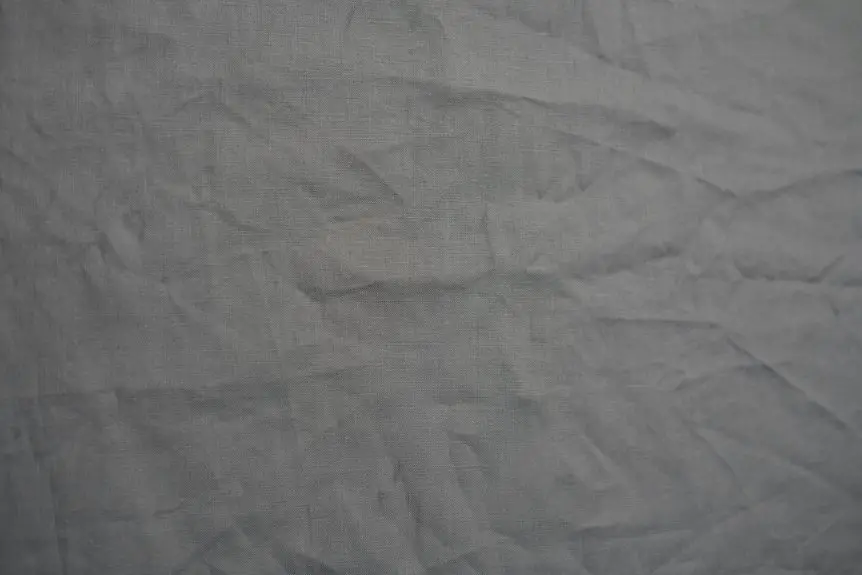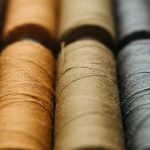To get wrinkles out of polypropylene fabric, start by laying it flat and lightly spraying water on the creases. Use a low-heat iron set to synthetic or the lowest option, and protect the fabric with a pressing cloth while keeping the iron moving to prevent melting. Alternatively, hang the fabric and gently steam it from a distance without soaking. Afterward, dry on low heat and store properly to avoid future wrinkles. You’ll find even more helpful tips as you explore this topic further.
Table of Contents
Key Takeaways
- Lay the polypropylene fabric flat and lightly dampen with water using a spray bottle before wrinkle removal.
- Use a low heat iron setting with a pressing cloth, keeping the iron moving to avoid melting or warping.
- Hang the fabric and gently steam wrinkles using a handheld steamer or steam iron function from a distance.
- Tug and smooth the fabric by hand while steaming to help relax and remove wrinkles effectively.
- Prevent wrinkles by washing in cold water on a gentle cycle and air drying or using low heat drying.
Understanding the Properties of Polypropylene Fabric
Polypropylene fabric is a synthetic material known for its durability and resistance to moisture. When you work with it, you’ll notice it’s lightweight, strong, and doesn’t absorb water easily. These qualities make it great for outdoor gear and activewear.
However, since it’s a thermoplastic, it can melt or warp under high heat, so you need to be cautious when ironing or applying heat. Polypropylene also resists many chemicals, which helps keep it looking fresh.
On the downside, it wrinkles easily because of its structure, but these wrinkles don’t set in as stubbornly as other fabrics. Understanding these traits helps you handle polypropylene properly and choose the best methods to remove wrinkles without damaging the fabric.
Preparing Your Polypropylene Fabric for Wrinkle Removal
Before you start removing wrinkles, you’ll want to gather a few essential tools and prepare the fabric properly. This guarantees effective wrinkle removal without damaging your polypropylene fabric.
First, lay your fabric flat on a clean, dry surface to inspect for stubborn creases. Next, check the care label to confirm polypropylene content and any washing instructions.
Then, lightly dampen the fabric using a spray bottle filled with water—this helps relax the fibers. Finally, remove any objects like pins or clips that could interfere with the wrinkle removal process.
Safe Ironing Techniques for Polypropylene
When you iron polypropylene fabric, it’s essential to use a low heat setting to prevent melting or warping the material. Always set your iron to the synthetic or lowest heat option. Avoid pressing the iron directly on the fabric; instead, use a pressing cloth to protect the fibers. Keep the iron moving continuously to prevent heat buildup.
| Step | Tip |
|---|---|
| Heat Setting | Use low or synthetic setting only |
| Iron Placement | Always use a pressing cloth |
| Iron Movement | Keep iron moving, don’t hold still |
Following these techniques will help you safely remove wrinkles without damaging your polypropylene fabric.
Using Steam to Smooth Out Wrinkles
Although polypropylene fabric can be sensitive to heat, you can safely use steam to relax wrinkles without risking damage.
Steam helps soften fibers, making wrinkles easier to smooth out without direct contact. Here’s how to use steam effectively:
- Hang the fabric on a sturdy hanger to keep it taut.
- Use a handheld steamer or the steam function on your iron, keeping the device at least 6 inches away.
- Slowly move the steamer over the wrinkled areas, allowing steam to penetrate without soaking the fabric.
- Gently tug and smooth the fabric with your hands as you steam for better results.
Preventing Wrinkles in Polypropylene Fabric
Since polypropylene fabric tends to wrinkle easily, taking simple steps during washing, drying, and storage can help you keep it smooth and wrinkle-free.
First, wash your polypropylene items in cold water on a gentle cycle to minimize agitation, which causes wrinkles. Avoid overloading the machine so the fabric has room to move.
When drying, use a low heat setting or air dry to prevent heat damage and excessive creasing. Remove the fabric promptly once dry to avoid set-in wrinkles.
For storage, fold polypropylene pieces carefully or hang them on padded hangers to maintain their shape. Avoid cramming your closet or drawers, as tight spaces increase wrinkling.
Frequently Asked Questions
Can Polypropylene Fabric Be Washed in a Washing Machine?
You can wash polypropylene fabric in a washing machine like a breeze flowing through trees. Just use cold water, a gentle cycle, and mild detergent to avoid damage. Avoid high heat when drying to keep it intact.
How Long Does Polypropylene Fabric Typically Last?
Polypropylene fabric typically lasts 5 to 10 years, depending on use and care. You’ll want to avoid harsh chemicals and excessive heat to keep it durable. With proper maintenance, it’ll serve you well over time.
Is Polypropylene Fabric Hypoallergenic?
You might worry about allergies, but polypropylene fabric is hypoallergenic, making it great if you have sensitive skin. It resists bacteria and allergens, so you can enjoy its durability without irritating your skin or causing reactions.
Can Polypropylene Fabric Be Recycled?
Yes, you can recycle polypropylene fabric, but it depends on local facilities. You’ll want to check if your recycling center accepts it, as polypropylene is a type of plastic that can be recycled into new products.
What Are Common Uses of Polypropylene Fabric?
Think of polypropylene fabric as a trusty Swiss Army knife—you’ll find it everywhere! You use it in reusable bags, sportswear, upholstery, and even outdoor gear because it’s durable, lightweight, and resists stains and moisture effortlessly.
- Tetron Fabric for Marine Applications: Durability and Use Cases - June 18, 2025
- Tetron Fabric for Outdoor Furniture: Weather Resistance and Care - June 18, 2025
- Tetron Fabric for Wall Coverings: Style and Application Tips - June 18, 2025







